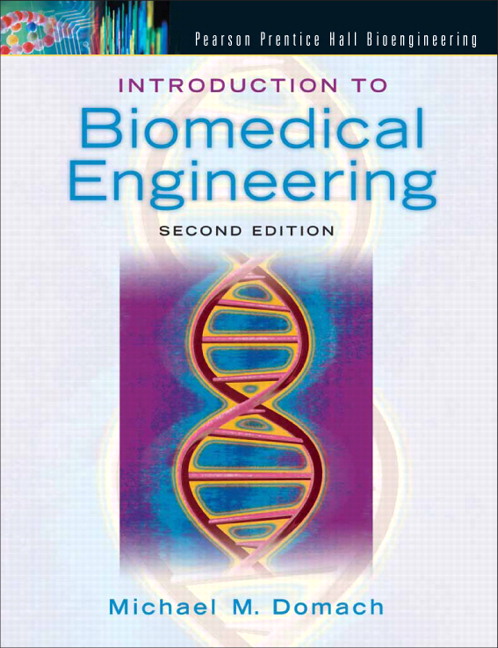Solution Manual for Introduction to Biomedical Engineering 2nd Edition by Domach
$35.00 Original price was: $35.00.$26.50Current price is: $26.50.
Solution Manual for Introduction to Biomedical Engineering 2nd Edition by Domach
Instant download Solution Manual for Introduction to Biomedical Engineering 2nd Edition by Domach pdf docx epub after payment.

Product details:
- ISBN-10 : 0136020038
- ISBN-13 : 978-0136020035
- Author: Michael M. Domach
Substantial yet reader-friendly, this introduction examines the living system from the molecular to the human scale–presenting bioengineering practice via some of the best engineering designs provided by nature, from a variety of perspectives. Domach makes the field more accessible, helping readers to pick up the jargon and determine where their skill sets may fit in. KEY TOPICS: Cellular and Molecular Building Blocks of Living Systems; Mass Conservation, Cycling, and Kinetics; Requirements and Features of a Functional and Coordinated System; Bioenergetics; Molecular Basis of Catalysis and Regulation; Analysis of Molecular Binding Phenomena; Applications and Design in Biomolecular Technology; Metabolic and Tissue Engineering; Primer on Tissues and Organs; Biomechanics; Biofluid Mechanics; Biomaterials; Pharmacokinetics; Noninvasive Sensing and Signal Processing. MARKET: A useful resource for anyone interested in join
Table Of Contents:
PART I: OVERVIEW OF BIOENGINEERING AND MODERN BIOLOGY
1(34)
What Is Bioengineering?
3(16)
Purpose of This Chapter
3(1)
Engineering versus Science
4(1)
Bioengineering
4(7)
Career Opportunities
11(4)
Further Consideration of the Ethical Dimensions of Bioengineering
15(4)
Cellular, Elemental, and Molecular Building Blocks of Living Systems
19(16)
Purpose of This Chapter
19(1)
Origins and Divergence of Basic Cell Types
20(3)
Elemental and Molecular Composition of a Cell
23(2)
Molecules That Contain Information
25(3)
Unique versus Interchangeable Parts Leads to Molecular-Based Classification
28(1)
Cellular Anatomy
29(1)
Cellular Physiological Lifestyles
30(1)
Viruses
31(1)
Prions
31(4)
PART II: SYSTEM PRINCIPLES OF LIVING SYSTEMS
35(64)
Mass Conservation, Cycling, and Kinetics
37(21)
Purpose of This Chapter
37(2)
Open versus Closed Systems
39(1)
Steady State versus Unsteady State
39(1)
Approaches to Performing Mass Balances
40(4)
Recycle, Bypass, and Purge
44(3)
Kinetics
47(3)
Unsteady-State Mass Balances
50(3)
Review of Moles, Molecular Formulas, and Gas Compositions
53(5)
Requirements and Features of a Functional and Coordinated System
58(12)
Purpose of This Chapter
58(1)
Chemical Reaction Rate Acceleration
59(2)
Energy Investment to Provide Driving Forces for Nonspontaneous Processes
61(2)
Control and Communication Systems
63(7)
Bioenergetics
70(29)
Purpose of This Chapter
72(1)
Bioenergetic Units
72(1)
Sensible versus Latent Heat
73(1)
The First Law of Thermodynamics Works on All Scales
73(1)
Using the First Law in Energy Balancing
74(1)
Bioenergetics at the Human Scale
74(6)
How Energy Is Produced, Stored, and Transduced at the Cellular Level
80(5)
Representative Energetic Values at the Cellular Level
85(1)
More Sophisticated Chemical Energy Accounting (Optional)
86(3)
Electrochemical Potential Calculation Examples and Applications (Optional)
89(4)
Why Coupling between Energy Evolving Reactions and ATP Formation Is Imperfect (Optional)
93(1)
Biological and Medical Applications of Membrane Energetization
94(5)
PART III: BIOMOLECULAR AND CELLULAR FUNDAMENTALS AND ENGINEERING APPLICATIONS
99(74)
Molecular Basis of Catalysis and Regulation
101(10)
Purpose of This Chapter
102(1)
Binding in the Biological Context
102(1)
Binding Is Dynamic
103(1)
Different Venues in Which Binding Operates
104(7)
Analysis of Molecular Binding Phenomena
111(17)
Purpose of This Chapter
111(1)
General Strategy for Problem Formulation and Solution
112(2)
Analysis of a Single Ligand-Single Binding Site System
114(2)
How to Decide What the Free Ligand Concentration Is
116(1)
Examples of Binding Calculations
117(1)
Analysis of Binding When Enzyme Catalysis Occurs
117(3)
A Protein with Multiple Binding Sites
120(3)
Further Thoughts on How Living Systems Are Designed and Function
123(5)
Applications and Design in Biomolecular Technology
128(16)
Purpose of This Chapter
128(1)
Binding Applications
129(3)
Enzyme Catalysis Application
132(6)
Using Enzymes in Food Processing
138(1)
Bioresource Engineering
138(1)
Immobilized Enzymes in Chemical Weapon Defense and Toxic Chemical Destruction
139(5)
Cellular Technologies and Bioinformatics Basics
144(29)
Purpose of This Chapter
144(1)
Microbial Metabolic Engineering
145(9)
Tissue Engineering
154(6)
Gene Theraphy and DNA Vaccines
160(1)
People also search:
|
introduction to biomedical engineering 2nd edition
|
|
introduction to biomedical engineering enderle pdf
|
introduction to biomedical engineering
|
intro to biomedical engineering pdf
|
|
introduction to biomedical engineering technology pdf
|
You may also like…
Solution Manual
Solution Manual
Solution Manual
An Introduction to Geotechnical Engineering Holtz Kovacs 2nd Edition Solutions Manual
Solution Manual
Solution Manual
Solution Manual for Introduction to Environmental Engineering – SI Version, 3rd Edition
Solution Manual
Solution Manual for Introduction to Engineering Experimentation 3rd Edition by Wheeler
Solution Manual
Solution Manual for An Introduction to Mechanical Engineering 3rd Edition by Wickert
Solution Manual
Solution Manual for Introduction to Materials Science and Engineering A Guided Inquiry by Douglas












